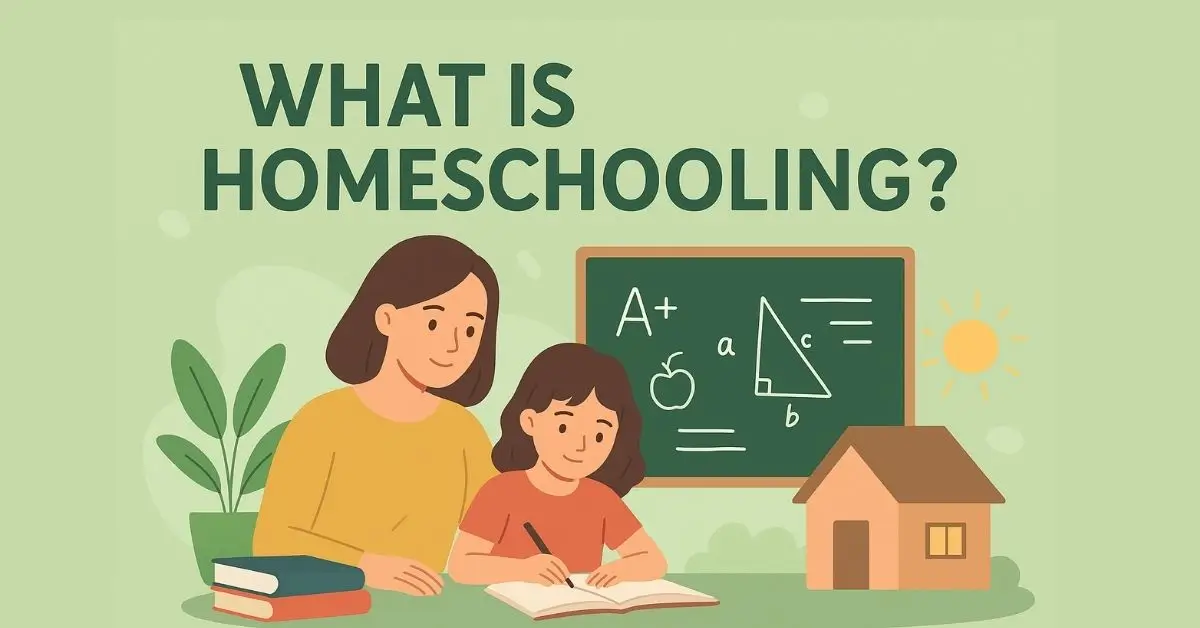Homeschooling is becoming increasingly popular every year, but many people still wonder what it truly entails and how it operates. In this detailed guide, you’ll learn what is Homeschooling? how it started, its benefits and challenges, different types, and how to start homeschooling your child—step by step.
Let’s break it down clearly and simply.
Table of Content
Table of Contents
What Is Homeschooling?
Homeschooling is an education system where children learn at home instead of attending a traditional public or private school. Parents (or tutors) take responsibility for teaching the child, using structured lessons, educational materials, and real-life experiences.
In short, Homeschooling allows parents to design a personalized education plan based on their child’s learning style, pace, and interests. (hstech)
How Homeschooling Works
Homeschooling doesn’t mean kids sit at home all day doing worksheets. It’s flexible and creative.
Parents can use different teaching methods and curricula, such as:
- Online homeschooling programs
- Printed textbooks and workbooks
- Virtual classrooms or tutoring sessions
- Field trips, experiments, and hands-on projects
- Community classes or co-ops (where groups of homeschool families meet and learn together)
Most families follow a daily or weekly schedule, balancing core subjects like math, science, and language arts with creative or practical learning such as art, coding, or cooking.
A Brief History of Homeschooling
Homeschooling isn’t new—it’s actually how most people were educated centuries ago. Before public schools existed, parents and tutors taught children at home.
The modern homeschooling movement began in the 1970s, when educators like John Holt encouraged parents to take more control of their children’s education. Since then, Homeschooling has grown worldwide, especially in the U.S., U.K., Canada, and Australia.
Today, millions of students are homeschooled worldwide, and the number continues to rise annually. Nanotechnology Applications: 5 Top Fields Using This Powerful Tech
Why Parents Choose Homeschooling
There are many reasons why families choose Homeschooling. Some of the most common include:
1. Personalized Learning
Children can learn at their own pace without pressure from large classrooms or strict schedules.
2. Safer Environment
Parents can provide a secure and positive learning space, free from bullying or peer pressure.
3. Flexible Schedule
Homeschooling allows for more family time, travel, and exploring interests outside of academics.
4. Better Focus on Values
Some parents prefer to incorporate moral, cultural, or religious education into their teaching.
5. Special Learning Needs
Homeschooling works well for children with learning differences (like ADHD or dyslexia) who need custom approaches.
Different Types of Homeschooling Methods
Homeschooling can take many forms. Here are the most popular methods parents use:
| Method | Description |
|---|---|
| Traditional Homeschooling | Follows a school-like schedule with textbooks, grades, and exams. |
| Unschooling | Learning is based on the child’s curiosity, without a fixed curriculum. |
| Online Homeschooling | Uses virtual courses, live classes, and digital assignments. |
| Charlotte Mason Method | Focuses on literature, nature studies, and moral development. |
| Montessori Approach | Hands-on, self-directed learning that promotes independence. |
| Eclectic Homeschooling | A mix of multiple methods depending on the child’s needs. |
There’s no “right” method—the best one depends on your child’s personality and family goals.
Homeschooling Laws and Requirements
Every country—and even every state—has its own laws governing Homeschooling.
Before you begin, it’s essential to verify your local regulations.
For example, in the United States, most states require parents to:
- File a notice of intent to homeschool
- Keep records of attendance and subjects taught
- Submit yearly assessments or evaluations
In other regions, rules may be more flexible. Always make sure you’re following legal guidelines to avoid future issues.
Benefits of Homeschooling
Homeschooling offers a lot of advantages for both children and parents:
- Stronger family bonds
- Customized curriculum suited to a child’s learning pace
- Flexible learning environment
- Higher academic performance (in many cases)
- Real-world learning opportunities beyond textbooks
Numerous studies indicate that homeschooled students frequently score above average on standardized tests and transition smoothly to college life.
Challenges of Homeschooling
Like any educational method, Homeschooling also comes with challenges:
- Time commitment – Parents need to plan and teach regularly.
- Social interaction – Children need chances to meet and play with others.
- Financial cost – Parents may need to buy materials or give up full-time work.
- Motivation – Both parent and student must stay consistent and disciplined.
Most families overcome these with planning, online communities, and local homeschooling groups.
How to Start Homeschooling Step-by-Step
If you’re thinking about starting, here’s a simple plan:
- Research your local homeschooling laws
- Choose your homeschooling style (traditional, online, unschooling, etc.)
- Pick a curriculum or design your own
- Set a daily or weekly schedule
- Create a learning space at home
- Track progress and adjust as needed
- Join a local homeschooling group for support and social activities
Starting might feel overwhelming, but once you build a rhythm, it becomes easier and more rewarding.
Online Resources for Homeschooling
Here are some trusted sites to explore:
- Khan Academy – Free lessons for all grades
- Time4Learning – Complete online homeschooling curriculum
- Homeschool.com – Community, tips, and resources
- National Home Education Research Institute (NHERI) – Research and reports on Homeschooling
Final Thoughts
Homeschooling is not just about studying at home—it’s about creating a personalized, flexible, and fulfilling learning journey for your child.
It empowers parents to teach in a way that aligns with their child’s needs and prepares them for real life.
If done with commitment and balance, Homeschooling can help children grow into confident, capable, and independent learners.



